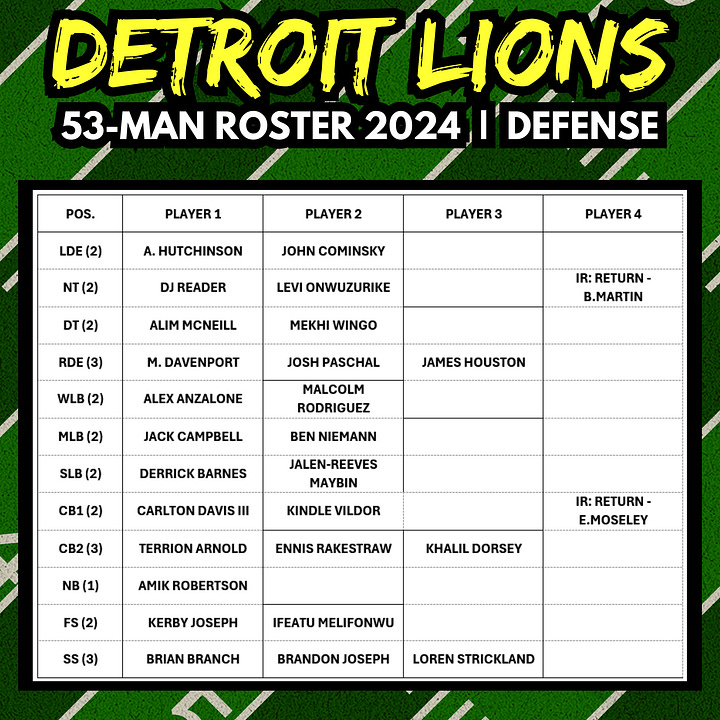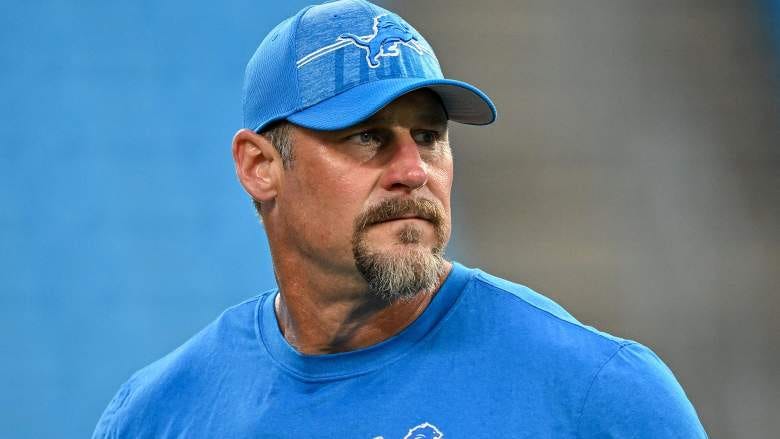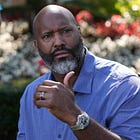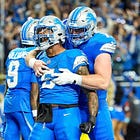A Deeper Dive Into The Detroit Lions Biggest Roster Hurdle, Defensive Line Depth & Position Flex Impacts
With The 53-Man Cutdown Just 4 Days Away | Rock's Locks Version 4
As the NFL’s August 26th cutdown deadline looms, every team—including the Detroit Lions—must trim their rosters from 90 players to the final 53 by 4pm EST on August 26th, 2025.
This article will explore key aspects of roster construction, the impact of injury designations on roster decisions, and the challenges posed by deep positional groups that complicate cuts.
The Biggest Roster Hurdle
Every season coaches and GMs have a huge hurdle when navigating the injury bug and previous season-ending injuries, OTAs or rookie camp injuries.
Players currently on the Active/Physically Unable to Perform (PUP) or Active/Non-Football Injury (NFI) lists face a unique set of rules that can dramatically impact both their season and the team’s roster flexibility. What many fans might not realize is that not every player on the summer roster is eligible for the initial 53-man roster, simply due to the injury designation process.
Here’s the key: if a player remains on Active/PUP or Active/NFI at the time of final cuts, the team must make a decision.
Move the player to Reserve/PUP or Reserve/NFI, which frees up a roster spot but requires the player to miss at least the first four games of the regular season.
Activate the player to the 53-man roster, which means they’re eligible to play Week 1—but now count against the team’s roster limit.
Or, in rare cases, release or waive the player with a failed physical designation.
For the Lions, this decision is especially relevant and equally as important with several players still working back from 2024 season ending or new injuries sustained during 2025 workouts, practice, or OTAs.
Active/PUP/NFI
Alim McNeill, (active/PUP), suffered a torn ACL in the December 15 game against Buffalo. His expected to return date is roughly mid-October per various reports. Malcolm Rodriguez is reportedly making solid strides in his recovery from a torn ACL sustained against the Chicago Bears last Thanksgiving, due back around mid-October. Rookie offensive guard Miles Frazier suffered a knee injury during spring OTAs and is expected to return by late September.
Defensive end Josh Paschal (active/NFI) has been sidelined all season with an undisclosed injury. Head coach Dan Campbell indicated that while Paschal was initially projected to return by early September and has been training on the sidelines, he is now behind schedule as of August 21.
At this juncture, it is anticipated that these players will remain on the active/PUP list leading up to the final cuts on August 26 at 4 PM.
Active/PUP Returns
The Lions made the move in back to back days this week to return defensive linemen Mekhi Wingo and special teams ace Khalil Dorsey from active/PUP back to the 90-man roster. Both players are now NOT eligible to return to PUP lists until after 53-man cuts. Which means, any setback could potentially end their seasons on IR (injured reserve).
New/Non-Designated Injuries
Rookie defensive lineman Ahmed Hassanein sustained a pectoral injury during the second half against the Miami Dolphins on August 16. Head Coach Dan Campbell indicated that Hassanein will be sidelined for an extended period but later confirmed that he will avoid surgery and is expected to return this season.
Lions safety Morris Norris is currently in concussion protocol after being transported off the field by ambulance following the team's August 8 game against Atlanta.
Both Hassanein and Norris may be placed on Injured Reserve with designation to return before the final roster cuts on August 26, 2025. This move would free up a roster spot, but both players would miss at least the first four weeks of play.
Additionally, Trystan Colon suffered an elbow injury during the August 8 preseason game against the Falcons. Fortunately, he has not been placed on Injured Reserve; however, his timeline for return remains uncertain.
The 4-Week Roster Risk
If the aforementioned players are not medically cleared by August 26th, Detroit will likely move them to reserve/PUP or reserve/NFI based on their current injury designations. This decision would sideline them through Week 4, with the option to return in Week 5 of the regular season.
This strategic trade-off safeguards a roster spot in the short term but necessitates losing the player temporarily. Such rules often go unnoticed yet serve as vital tools for general managers balancing depth, development, and game-day readiness. It also clarifies why some seemingly healthy players remain inactive until October—their injury statuses effectively mandate their absence.
For fans monitoring roster battles, grasping these designations is important; it distinguishes between mere speculation and understanding why a promising rookie or key veteran is absent from the field. It also allows for a better understanding as to why certain decisions were made ahead of cuts.
Deep Defensive Line Concerns
The Detroit Lions' defensive tackle and EDGE positions are among the deepest in the league, poised to see some talented players cut. This roster features a blend of seasoned veterans and promising newcomers competing for spots on the defensive line. With the team typically carrying 4-5 defensive tackles and 4-7 defensive ends, a new trend is emerging: the caliber of talent continues to rise each season.
2022: 5 DT & 5 DE | 2023: 5 DT & 7 DE | 2024: 4 DT & 5 DE | 2025: ?
Brad Holmes has prioritized positional flexibility, a strategy that remains consistent. As the roster matures with established players and veteran leaders bolstering critical positions, it has evolved to necessitate at least four defensive linemen capable of hybrid roles.
This hybrid strategy accommodates various body types, enabling smaller, quicker tackles to apply pressure from within or shift outside to disrupt plays while maintaining run control. It’s a framework designed for adaptability, particularly in response to injuries.
Just as receivers and running backs often serve dual roles as returners or gunners on special teams, linebackers and tight ends may slide into H-back positions. This versatility allows the Lions to optimize their roster and potentially create openings for less flexible but promising players whom they cannot afford to lose.
Next week, Brad Holmes and Dan Campbell will confront an intriguing dilemma as they evaluate eighteen players across four positions on the defensive line.
🔒= Roster Locks | 🔓= Fringe Warrior/Practice Squad | 📃 = Injury List Lock
Aidan Hutchinson (DE) Year 4: 🔒Enough said…
Alim McNeill (DT) Vet: 🔒 Enough said…
Marcus Davenport (DE) Vet: 🔒 Marcus Davenport is looking like a wrecking ball, coaches say he’s been the best player on the field during training camp. A physical force at 6’6", 285 pounds of edge-rushing chaos with rare burst and bend for his size. When healthy, he’s a game-wrecker, and his 9.5-sack season in New Orleans wasn’t a fluke—it was a glimpse of what he can do when unleashed. He’s long, explosive, and disruptive against both the pass and the run, with a win rate that ranks among the league’s best when he’s on the field.
Detroit signed him to a one-year prove-it deal, not a long-term gamble. The Lions don’t need 17 games—they need impact. If Davenport gives them 10 healthy weeks opposite Aidan Hutchinson, that’s a Superbowl-caliber pass rush and run stuffing machine. He’s not here to be perfect. He’s here to be dangerous, and when he’s right, few edge defenders are more disruptive, more powerful and more feared in the NFL, just ask our offensive line.
DJ Reader (NT/DT) Vet: 🔒Veteran defensive tackle DJ Reader has emerged as a cornerstone of the Detroit Lions’ defensive identity in 2025. Fully healthy after a quad injury derailed his 2023 season, Reader has looked rejuvenated in camp. From my eyes and various reports, Reader has been very disruptive in team drills, commanding double teams, freeing up lanes for the linebackers and edge rushers to get to the quarterback. He’s been vocal in meetings, and relentless in his mentorship of rookie Tyleik Williams, shaping him into a pro. With Alim McNeill sidelined until midseason, Reader’s role has expanded beyond gap control, hes who everyone looks to for guidance on the defensive line and in the community.
Tyleik Williams (DT): 🔒 A 2025 first round draft pick who has shown why his versatility is exactly what this team needed with Alim McNeill still out. In his only snaps versus the Falcons Williams ate double teams and never lost ground in his anchor and pin. Williams is an example of a player that can play anywhere on the line, inside or outside.
Roy Lopez (DT) Vet: 🔒 A vital piece to the defensive line rotation, Lopez has been a practice standout. Coaches and media have praised his pad level, leverage, and hand usage, all rooted in his wrestling background. He’s been a consistent force in joint practices and scrimmages. I expect Lopez to stick around for the forseeable future should he play well this season.
Pat O'Connor (DT) Vet:🔒 The definition of survival mode, O’Connor’s been everywhere this camp — nose, 3-tech, big end, even offering to play blocking TE if needed. He’s taken first-team reps and earned praise for his versatility and motor. Dan Campbell calls him “a jack of all trades”- O’Connor’s adaptability might be his ticket to week 1 snaps. His retention is vital for this defense.
Mekhi Wingo (DT/DE): 🔒After tearing his meniscus last Thanksgiving and undergoing a second knee procedure this spring, Wingo was activated from the PUP list just three weeks before the season opener. The biggest question is why now? Unless Wingo can contribute immediately, this move may not make sense. I hope the Lions are sandbagging here to not sacrifice the loss of a young player such as Kieth Cooper, who may be picked up immediately by another team when cut. Wingo is a player that offers inside / outside flex.
Al-Quadin Muhammad (DE) Vet: 🔒Quietly one of the most consistent performers in camp earning first-team reps and drawing praise from Dan Campbell for being “tough, relentless,” and improving his run defense. He’s been a menace in joint practices and filled in seamlessly when Hutchinson and Davenport rested. With Paschal and Wingo still recovering, Muhammad’s hybrid ability makes him a lock for the 53—and a sneaky rotational weapon. I could also see Muhammad on the vet squad with a hand shake deal, but he has earned his roster spot in my opinion.
Isaac Ukwu (DE): 🔒 Once a practice squad elevation turned preseason standout. Added 10 pounds this offseason and now plays both edge and 4i technique. Earned an 83.3 PFF grade vs. Miami and notched a sack on Zach Wilson. Coaches love his versatility, power rush and edge-setting ability, but open roster spots are trending down. This is the problem for the Lions this season. Players like Ukwu could be cut and will be picked up. I see Ukwu on the roster as injuries to Ahmed Hassanein and Josh Paschal have opened at least one spot for Ukwu to slide into.
Nate Lynn (DT): 🔒 Nate Lynn is turning heads in Detroit—and not just as a feel-good comeback story. After missing all of 2024 with an injury, the undrafted EDGE out of William & Mary has stormed into 2025 training camp with something to prove. And prove it he has. Lynn’s stock is rising fast. He’s stacked multiple strong preseason performances, including four pressures and a sack in Week 1, and a clutch tackle for loss against Miami that flipped possession. Lions GM Brad Holmes even called him his “dark horse to make the team” during the broadcast—a rare public endorsement that speaks volumes.
Josh Paschal (DE/DT): 🔒📃Entering his final year of his rookie contract, Paschal’s NFL journey began with promise and pedigree in 2022. Paschal was heralded for his versatility, leadership, and relentless motor with interior and exterior flexibility. He was expected to be a foundational piece in Detroit’s defensive rebuild—a high-character, high-effort player who could complement Aidan Hutchinson and bring juice to the pass rush. Availability is key in the NFL, all the pretty words and stats on paper are meaningless without consistency and substance to back it up.
Ahmed Hassanein (DE) Rookie: 🔒📃 Ahmed Hassanein’s preseason was quietly promising before a pectoral injury derailed his momentum. The sixth-round rookie out of Boise State showed flashes of edge-setting ability and urgency in limited reps, notching pressures in both preseason outings and tallying three run stops in the Hall of Fame Game. His play wasn’t dominant, but it was disruptive enough to suggest he belonged in the Lions’ developmental pipeline.
I am expecting Detroit to place Hassanein on injured reserve before final cuts. Doing so preserves his rights while freeing up a roster spot, and avoids the risk of losing him on waivers.
Hassanein’s rawness was expected, but his intensity, football IQ, and physical traits made him a viable depth piece behind Hutchinson and Davenport. With Detroit’s edge group already thin, stashing Hassanein now is a smart investment in a player who could contribute once healthy. He’s earned that chance.
Chris Smith (DT): 🔓A Harvard-to-Notre Dame product with a pre-med brain and trench toughness. Logged snaps in five games last season and re-signed on a one-year deal. Quiet but reliable rotational piece—think gap integrity over splash plays. Less of a flexible player, Smith is going to play inside the majority of the time.
Myles Adams (DT) : 🔓 Poached off the seahawks practice squad last season, Adams logged a sack in his 1st game as a Detroit lion. Coaches say he’s had “a pretty good camp” and he’s pushing for a backup DT role. Adams is also another player that offers flex inside and outside. He is fast off the ball and has been utilized at both end positions.
Brodric Martin (DT): 🔓 Brodric Martin’s rare frame—6'5", 330 pounds with long arms and raw power as a space-eater is exactly why Brad Holmes took a swing on him in the third round of the 2023 draft. Holmes has consistently targeted traits over polish early in the roster building effort. After a hyperextended knee wiped out most of his 2024 season, fast forward to 2025, and Martin is battling uphill to make the Lions’ 53-man roster.
Martin entered camp buried on the depth chart behind DJ Reader, Tyleik Williams, Roy Lopez, and Pat O’Connor. A recent foot injury only complicates his case. He’s a strong candidate for the practice squad. He may not be ready for Sundays yet, but if he stays healthy and keeps grinding, the Lions could still mold him into a rotational force for when DJ Reader is no longer on the roster, potentially after this season.
Keith Cooper Jr. (DE): 🔓Undrafted but not unnoticed. The Houston transfer has flashed inside-out versatility, flashing the positional villain Brad Holmes covets and violent hands inclusive of a push pull technique that is a savvy vet move you don’t see in young guys very often. Lions gave him a big UDFA investment, and now he’s battling for a final roster spot. I really like his film so far and expect great things for his future. He is stuck behind some really good football players, but this is one Brad Holmes cannot miss. Cooper must be locked down somehow.
Mitchell Agude (DE): 🔓 Despite being listed as a second-string EDGE on the Lions’ initial depth chart—alongside Josh Paschal and ahead of veterans like Al-Quadin Muhammad and rookie Ahmed Hassanein—Agude’s grip on a roster spot has weakened after two preseason games. He’s logged limited production and hasn’t made a splash in joint practices or team drills. He’s shown flashes, sure, but flashes don’t cut it in Dan Campbell’s system, where consistency and pressure production are non-negotiable. Through two preseason games, Agude’s impact has been minimal, and joint practices haven’t helped his case. With Nate Lynn surging and Isaac Ukwu getting reps in Hassanein’s absence, Agude’s path to the 53-man roster is narrowing fast.
Roster Structure Is Built To Sustain
Since 2023, the Detroit Lions have adhered to a remarkably consistent roster blueprint, and 2025 is no exception. General Manager Brad Holmes has cultivated a core that is stable, strategic, and structurally sound. The positional breakdowns have remained largely unchanged over the past three seasons, a deliberate choice.
In 2021 and 2022, the Lions operated in full acquisition mode—draft picks were not merely developmental projects; they were immediate contributors. Nearly every rookie received significant playing time as the front office prioritized depth and cultural cohesion.
Everything changed in 2023 when Detroit secured four legitimate day-one starters—Jahmyr Gibbs, Jack Campbell, Sam LaPorta, and Brian Branch—in a single draft class. This achievement allowed the Lions GM to transition from merely filling roster gaps in free agency to strategically fine-tuning the team. He addressed pressing needs, particularly at cornerback, through targeted free agency signings and two early round draft picks, as well as short-term contracts across various positions throughout 2024. Giovanni Manu was the sole "project" selected in this draft; however, one cannot overlook the impressive size and potential he brings to the table.
Now in 2025, this pattern persists. The core remains intact, positional ratios are stable, and roster battles focus on refinement rather than desperation. One-year contracts continue to circulate, providing flexibility without undermining the foundation. This reflects a mature roster—crafted not just for competition but for sustained success.
Change In Brads Tune
I have been very adament about the fact I was expecting the day to come where “projects” can no longer be an option. After the 2024 draft, the roster had finally reached that boiling point, now forcing Brad Holmes’ hand to be extra selective moving forward.
In the early stages of a coaching and GM change, 2021 - 2023, teams often carry a surplus of developmental players: raw prospects with upside, long-term potential, and traits worth cultivating. These players are given time, reps, and patience because the roster itself is still under construction. As talent matures and the core group of leaders and starters solidifies, the margin for error shrinks. Suddenly, the luxury of “room” for projects becomes a strategic dilemma.
This year, that tension has become especially visible. The team’s foundational pieces—draft hits, free agent signings, and breakout contributors—have elevated the overall standard. Veterans are playing faster, smarter, and more consistently. The bar has been raised, and with that rise comes a painful truth: not every promising rookie or second-year player can be kept, even if the coaching staff genuinely believes in their long-term trajectory.
How does that affect this roster? Simple, if you are a draft pick currently on the bottom and a project. You won’t be making this roster over a priority UDFA, or any other draft pick that is playing well and doesn’t hold the team back.
Positional Flex
Mentioned above, the core is set and the positional flexability is broad with several players allowing for flexability covering multiple roles. An example of this, is where I see an option for the Lions to keep an extra receiever this season simply because flexability exists with the offensive line. Graham Glasgow can played all the positions, Tate Ratledge can play center and guard, and Jamarco Jones can also play both tackle and guard positions. The combination of positional flex could force the Lions to keep 9 offensive linemen instead of 10 allowing for an extra player somewhere else on the roster and leaving Miles Frazier on a list to start the season.
The below graphics show you the initial 53-man rosters from 2024


Rock’s Final Take
As previously noted, the core of the Lions' roster is firmly established, and the impressive breadth of positional flexibility among players stands out. This versatility allows several athletes to assume multiple roles effectively, enabling General Manager Brad Holmes to retain talent even when faced with tough decisions regarding fringe players who might otherwise be cut. Many teams lack this level of positional flexibility, which positions the Lions to endure longer and more challenging seasons as injuries accumulate.
The adaptability of the offensive line exemplifies this strength; it could allow the Lions to carry nine offensive linemen instead of the usual ten. This strategy would enable them to stash a veteran on the practice squad while freeing up a roster spot for an additional player in another position group, thereby maximizing overall talent.
Such strategic maneuvering not only enhances depth but also provides greater tactical flexibility during games, ultimately bolstering the team's competitiveness. By optimizing each roster spot through positional versatility, Detroit can respond more effectively to injuries or game situations without sacrificing performance on either side of the ball.
Best defense ever LOADING!










Great article!! Go Lion's!!